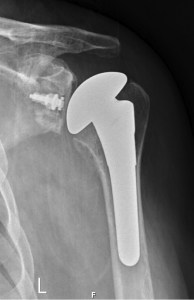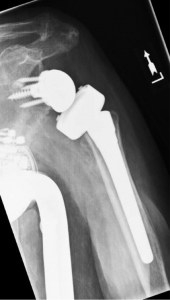Shoulder joint replacement is an excellent way to relieve pain in cases of severe arthritis of the shoulder, and sometimes for fractures or other conditions.
Nonsurgical treatments like medications and activity modification should always be tried before surgery. However, if these either fail to work, or stop working for you, you may be a candidate for shoulder joint replacement surgery.
“Traditional” shoulder replacement involves resurfacing the normal humerus “ball” with an alloy metal ball, and the cup on the shoulder blade with a plastic one (sometimes with a metal pin on the back, helping to hold the cup in place long-term):

About 53,000 people in the U.S. have shoulder replacement surgery each year, far fewer than the over-800,000 knee and hip replacements performed annually.
There are some patients with arthritis who cannot have successful traditional shoulder replacement surgery. These include patients with severe, irreparable rotator cuff tendon tears, some fractures, and tumors. For them, “Reverse Shoulder Replacement” might prove a good alternative.
Reverse shoulder replacement involves the opposite: replacing the ball with a cup, and the cup with a ball. This rather odd-sounding combination allows patients to control the motion of the shoulder by substituting the deltoid muscle for the deficient rotator cuff muscles:

One of OSS Shoulder Specialists has extensive training and experience in both traditional and reverse shoulder replacement, and has worked with the designers of the prosthesis he uses for implantation. He would be happy to see you in clinic and evaluate whether you would be a good candidate for this procedure.

